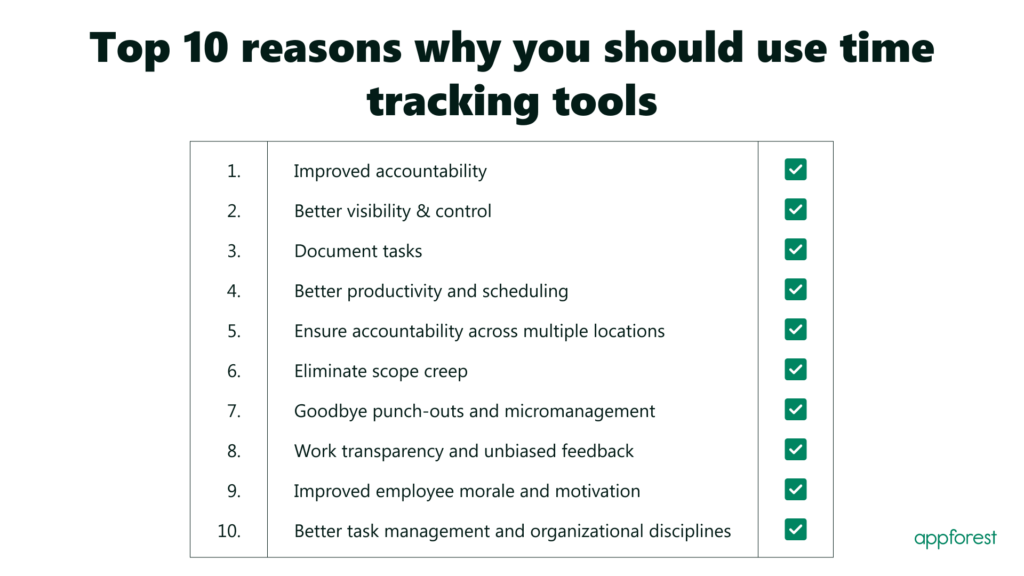Keeping track of what each employee does is a time-consuming and resource-intensive process. Conventional manual time tracking is ineffective as well. This is why employee time tracking is a huge hit.
Every business relies on time tracking tools to provide accurate employee payroll. Research reveals that 43% of time-tracking users are in control of their work hours five days a week, compared to only 26% of non-users. It is clear that using the best employee time tracking is only advantageous.
Nevertheless, here are the top 10 tangible benefits of employee time tracking with Jira integration.

Improved accountability
Employee time tracking reinforces accountability. This is crucial because most employees don’t feel important and invaluable to their projects, potentially due to a lack of recognition at work. Studies show that 67% of employees feel unappreciated at work.
Time tracking tools inform employers of what employees have worked on, when the tasks were completed, and how much time and effort they put in. It’s like a tangible record of what all the employees did, which can’t be overlooked.
Employee time trackers allow managers to analyze the hours an employee has dedicated to specific tasks. This enables them to assign the most productive team members to the right projects and maximize workforce efficiency.
Moreover, recognizing good work is essential. Employee time tracking helps in performance evaluation and allows employers to shift from a monitoring role to appreciating and rewarding employees for their dedication and focus.
Better visibility & control
Employee project time tracking software helps identify problems early on. This avoids wasting extra effort and time trying to fix the whole team when the problem might only involve a few people. Ignoring unrelated issues will only create confusion and make it harder to achieve company goals.
This is why time tracking enables you to identify where employees are investing their efforts and objectively measure outcomes, helping you determine whether the time spent is truly valuable.
When a company doesn’t effectively use its employees, it can hurt its profits. For example, paying salaries and benefits for employees who aren’t fully utilized is a waste of money. Properly using employees can lead to better efficiency and productivity.
On the other hand, if employees are idle, the company might spend more on recruiting and training new staff when work needs to be done. Over time, this can increase and reduce the company’s overall profits. Opting for ideal automated timesheets for Jira that automatically calculate time spent on each project could be a saver in such situations.
Document tasks
Peter Drucker, a well-known business expert, once said that time is our most limited and valuable resource. McKinsey & Company’s quarterly report also stressed the importance of time management for organizations.
They surveyed nearly 1,500 executives worldwide and found that only 52% felt their time was being used in ways that matched their company’s strategic goals. Almost half of the executives admitted they weren’t spending enough time focusing on guiding their business’s long-term direction. This is where Jira timesheet software integration can help.
Time tracking tool for employees to record which team members work on which tasks. Since time trackers show when employees start and stop working, managers can see how much time is spent on specific tasks.
This information can be helpful during annual reviews, where employees and managers discuss the tasks completed and the time spent on them. It can highlight an employee’s strengths or areas for improvement. Keeping such records can also help when discussing changes in roles or responsibilities.
Better productivity and scheduling
Time tracking helps employees develop better time management skills, improving productivity over time. By tracking time for each project, managers can identify tasks that take longer than expected. It also allows employees to reflect on their work, minimize multitasking, and eliminate distractions that hinder efficiency.
Employee time tracking can boost productivity by reducing chances of distraction (productivity leaks) by 80% and improving revenue by 61%.
Time tracking tools enable companies to save thousands of dollars by letting them know exactly how many hours their employees worked. This is not a bad practice or micromanagement, nor is your employee cheating you.
But companies deserve to know exactly how many hours their employees work and pay them for what they owe. Businesses lose up to 8% of their annual payroll to minor errors and an additional 7% to time theft. Shockingly, 43% of employees admit to committing time theft. Employee time tracking solutions can avoid all of these.
Ensure accountability across multiple locations
Companies have branches in different locations, some even in the same state or small cities. Hence, it becomes difficult for managers to monitor all employees in various places. One plugin tool will help managers access everyone’s work status and tasks in one go.
The best part about employee time tracking software is that it doesn’t have to be connected to any electronic devices. All it needs is access to the Internet, and anybody can access the platform virtually anywhere. HR and project managers can track employees’ working hours and access detailed, granular reports anytime.
Eliminate scope creep
Scope creep refers to expanding the project timeline, features, tasks, or goals beyond what was initially decided. This happens when new features or requests are added to the project without evaluating their impact on cost, resources, or time.
Scope creep can delay projects, burn finances, and overwork the team. A Jira time tracking plugin can help avoid this situation.
These tools allow companies to preplan any unexpected expenses or additional work that might arise during the project. By tracking time and resources, businesses can better manage scope creep and stay on track with their original goals.
Goodbye punch-outs and micromanagement
Using time tracking tools is a boon for companies relying heavily on freelancers or contract-based workers. Traditional tracking methods, such as punchout systems or timesheets, have become inefficient.
Not only that, manual time tracking can be time-consuming for both managers and employees, taking significant time to complete, review, and approve. Such a hectic process is error-prone, eventually burning out more cash.
Additionally, micromanagement is a major issue that drains productivity. Managers want to know everything about a project, such as how long it is taking, what has been done so far, what the outcomes are, etc. Though it’s not their fault, such practice comes off as micromanaging every aspect of employees’ work lives. This will just restrict employees’ freedom to work on the given project.
Employee time tracking software can be used to reduce this issue by measuring project outcomes and timelines without being intrusive. Tracking time helps managers know what exactly is going on and measure the progress, performance data, etc, without physically monitoring each individual’s activity. This is a win-win for both parties.
Work transparency and unbiased feedback
Employee time tracking improves work transparency between employees and employers. Managers can understand which employees are working hard, which tasks are not being executed, etc. This allows employers to delegate tasks according to each employee’s capacity.
Some employees might be good with typing and finish writing tasks quicker, while others take more time. In such cases, employers can align tasks accordingly. Also, for teams that feel overburdened and unrecognised, a time tracking tool is an excellent way to get noticed and distribute work among other teams.
Also, since everyone knows the amount of time employees spend on each task, providing real-time feedback becomes quick and instant. It allows you to address any issues or potential bottlenecks during the project, eliminating the need to make changes at the end of tasks.
Such a situation helps create an ecosystem of continuous learning, ensuring companies meet their goals effectively.
Improved employee morale and motivation
Improving employee morale is one of the most important benefits of employee time tracking software. When everything is tracked, employees become confident that their efforts are being documented, enhancing their productivity.
However, companies must introduce Jira’s time tracking and project management tool as an additional feature to help employees develop their skills. If your staff views it as a means to micromanage, the entire purpose of implementing time tracking will be in vain.
Using JIRA time tracking, managers will be better able to allocate resources and plan tasks according to employees’ abilities and skill sets. This streamlined process enables quicker task completion and optimized workflow.
Jira time tracking software shows employees how much time they spend working versus not working. This can motivate them to stay productive and improve their efficiency throughout the day instead of losing focus or becoming less active.
Seeing these stats can also encourage employees to stay on task, take on new projects, and even go beyond what’s expected. It’s like a booster for employees.
Better task management and organizational disciplines
When you are integrating employee time tracking software into your process, it builds a solid foundation of organizational discipline. Employees feel accountable and transparent for their work.
When employees know there is a specific time (reasonable amount of time) attached to each task, they feel obliged to complete it, ensuring timely completion and efficient output. Such a structured system encourages employees to be disciplined staff members, improving overall productivity.
Teams become better at setting goals and achieving them, improving communication and departments, etc. Team members can now predict what resources or features will be needed and plan tasks ahead of time.
This gives managers more flexibility to focus on other important activities, like making phone calls, organizing emails, or having quick meetings with their team, instead of spending so much time on scheduling. Also, this tracks employee time effortlessly to boost productivity and efficiency.
Over to you
There are several different online employee time tracking tools available. Opting for one is a great way to understand what’s happening within your organization. It reduces the chances of error, eliminates manual tracking, and allows employees to be organized and in control of their tasks. Studies show that time tracking tools save money up to 20% per employee.
Also, it is by no means a micromanagement tool. Rather, the objective data provided by the JIRA time tracking tool can actually benefit company growth and employees’ skill sets.

